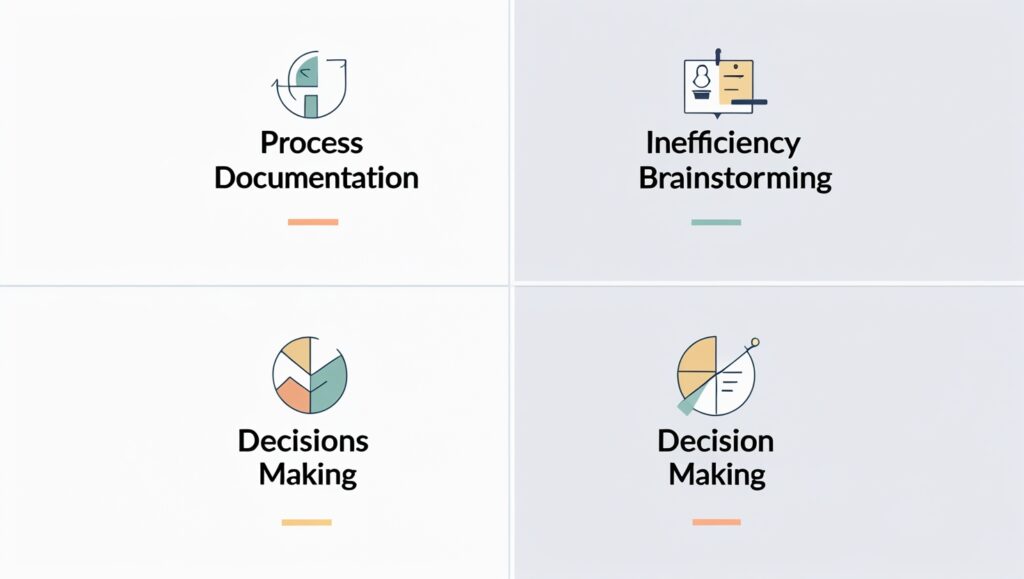The Ultimate Guide to AI-Powered Business Processes
Did you know that companies implementing AI-powered business processes report an average cost reduction of 40% and productivity gains of up to 60%? According to reports from firms like Deloitte, the organizations bridging the gap between AI’s promise and practical implementation are gaining unprecedented competitive advantages. This comprehensive guide will walk you through everything you need to know about transforming your business operations through intelligent process automation.
What Are AI-Powered Business Processes?
AI-powered business processes integrate artificial intelligence into organizational workflows to automate tasks, enhance decision-making, and optimize efficiency. Unlike traditional automation, which follows fixed rules, AI systems can learn and adapt. The foundation of successful implementation lies in understanding that AI augments human intelligence, it doesn’t replace it. While humans excel at strategy, AI excels at processing vast amounts of data and executing repetitive tasks with perfect consistency.
The Core Benefits of AI in Business Operations
1. Enhanced Operational Efficiency:
AI automation delivers unprecedented efficiency gains by eliminating bottlenecks. Organizations typically see a 30-50% reduction in processing times for routine tasks, allowing your team to focus on high-value activities.
2. Improved Data-Driven Decision Making:
Workflow automation AI enables real-time data analysis and predictive insights. AI can process millions of data points simultaneously, identifying trends impossible for humans to detect manually.
3. Significant Cost Reduction:
Business process automation tools with AI deliver significant cost savings through reduced labor and minimized errors. Studies show a 20-40% reduction in operational costs within the first two years.
Key AI Technologies Transforming Workflows
Machine Learning (ML):
ML algorithms form the backbone of most AI business applications, enabling systems to learn from experience. Applications include demand forecasting and financial risk assessment.
Natural Language Processing (NLP):
NLP enables computers to understand and respond to human language. Business applications include automated customer service and document analysis.
Robotic Process Automation (RPA):
RPA uses software robots to perform repetitive, rule-based tasks like data entry, invoice processing, and employee onboarding.
Practical Applications: Your AI-Powered Toolkit

This guide serves as a central hub, connecting you to detailed, practical articles on how to implement AI in specific business processes.
From Chaos to Clarity: AI for Process Documentation
One of the biggest challenges in any business is undocumented processes. Using AI, you can turn messy meeting notes into clear, standardized workflows. For a step-by-step guide, read our article: From Chaos to Clarity: An AI Prompt to Document Any Business Process.
Smarter Meetings: The AI-Powered Summarizer
Meetings often suffer from a lack of clear outcomes. A simple prompt can turn any meeting transcript into a concise summary with clear decisions and assigned tasks. Learn the exact prompt in our guide: Never Take Messy Meeting Notes Again: The 3-in-1 AI Summarizer Prompt.
Finding Inefficiencies: Your AI Brainstorming Partner
Sometimes the biggest inefficiencies are the ones we can no longer see. AI can act as an impartial brainstorming partner to analyze your workflows and suggest creative improvements. We provide five powerful prompts for this in our article: Your AI Brainstorming Partner: 5 Prompts to Find and Fix Inefficiencies.
Objective Analysis: AI for Decision Making
Human decision-making is prone to bias. By using a structured AI prompt, you can generate an objective analysis of the pros, cons, and hidden risks of any business choice. Find the master prompt in our guide: The AI Decision-Maker: A Prompt to Analyze Pros and Cons for Any Business Choice.
A 4-Phase Strategy for Implementing AI in Your Business
Phase 1: Assess and Identify Opportunities
Begin with a comprehensive assessment of your current business processes, identifying inefficiencies and bottlenecks. Create a cross-functional team to ensure AI solutions address real business needs.
Phase 2: Select a High-Impact Pilot Project
Choose an initial AI project with a manageable scope and high potential impact. Prioritize a use case where AI can demonstrate clear value quickly to build organizational confidence.
Phase 3: Implement and Train
Evaluate AI platforms and vendors based on your specific requirements. Plan integration carefully and, most importantly, invest in training programs for your team. Successful AI implementation requires managing the human element, a topic we’ll explore in our future article, “Change Management for AI: A Leader’s Guide”.
Phase 4: Measure, Iterate, and Scale
Establish clear KPIs before implementation. Track metrics like processing time, error rates, and cost savings. Use this data to justify expanded AI investments and scale successful pilots across the organization.
Frequently Asked Questions (FAQ)
Do I need to be a programmer to use AI in my business?
No. The modern wave of generative AI tools is designed for business users, not just technical specialists. The key skill is learning to ask the right questions (prompting), not coding.
What is the biggest mistake companies make when starting with AI?
Focusing only on the technology without a clear business problem to solve. AI should be implemented to address a specific inefficiency or opportunity.
How do I measure the ROI of AI implementation?
Calculate ROI by comparing implementation costs (software, training) against measurable benefits over time (labor cost savings, error reduction, revenue increases). Most organizations see positive ROI within 6-18 months.







